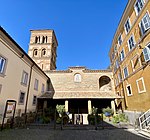Villa of Domitian
Alba LongaBuildings and structures in Albano LazialeBuildings and structures in Castel GandolfoDomitianRoman villas in Italy

The Villa of Domitian, known as Albanum Domitiani or Albanum Caesari in Latin, was a vast and sumptuous Roman villa or palace built by Emperor Titus Flavius Domitian (81–96 AD). It was situated 20 km (12 mi) outside Rome, in the Alban Hills, in the ancient territory of Ager Albanus (from the legendary Latin city of Alba Longa). Today the remains of the villa are located mostly within the estate of the Pontifical Villas of Castel Gandolfo, and the rest in the towns of Castel Gandolfo and Albano Laziale. The Villa Barberini gardens are open to visitors.
Excerpt from the Wikipedia article Villa of Domitian (License: CC BY-SA 3.0, Authors, Images).Villa of Domitian
Piazzale Quadrato,
Geographical coordinates (GPS) Address Nearby Places Show on map
Geographical coordinates (GPS)
| Latitude | Longitude |
|---|---|
| N 41.738348 ° | E 12.655029 ° |
Address
Piazzale Quadrato
00041
Lazio, Italy
Open on Google Maps











